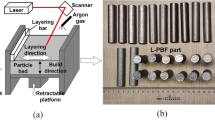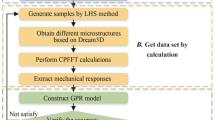Abstract
An inverse modeling approach was taken up in this work to model the process of recrystallization using cellular automata (CA). Using this method after formulating a CA model of recrystallization, differential evaluation (DE), a real-coded variant of genetic algorithms, was used to search for the value of nucleation rate, providing an acceptable matching between the theoretical and experimentally observed values of fraction-recrystallized (X). Initially, the inverse modeling was attempted with a simple CA strategy, in which each of the CA cells had an equal probability of becoming nucleated. DE searched for the value of the nucleation rate yielding the best results for single-crystal iron at 550 °C. A good match could not be simultaneously achieved this way for the early stages of recrystallization as well as for the later stages. To overcome this difficulty, the CA grid was divided into two zones, having lower and higher probabilities of nucleation. This resulted in good correspondence between the predicted and experimental values of X for the entire duration of recrystallization. The introduction of a distribution in the probability of nucleation made the model even closer to the actual process, in which the probability of nucleation is often nonuniform due to nonuniformity in dislocation density as well as the presence of grain/interface boundaries.
Similar content being viewed by others
References
K.W. Mahin, K. Hanson, and J.W. Morris, Comparative-Analysis of the Cellular and Johnson-Mehl Microstructures Through Computer-Simulation, Acta Metall., Vol 28, 1980, p 443–453
D.J. Srolovitz, G.A. Grest, and M.P. Anderson, Computer-Simulation of Recrystallization: 1. Homogeneous Nucleation and Growth, Acta Metall., Vol 34, 1986, p 1833–1845
D.J. Srolovitz, G.A. Grest, M.P. Anderson, and A.D. Rollett, Computer-Simulation of Recrystallization: 2. Heterogeneous Nucleation and Growth, Acta Metall., Vol 36, 1989, p 2115–2128
K. Marthinsen, O. Lohne, and E. Nes, The Development of Recrystallization Microstructures Studied Experimentally and by Computer-Simulation. Acta Metall., Vol 37, 1989, p 135–145
R.A. Vandermeer and B.B. Rath, Modeling Recrystallization Kinetics in a Deformed Iron Single-Crystal, Metall. Trans., Vol 20A, 1989, p 391–401
H.E. Vatne, T. Furu, R. Orsund, and E. Nes, Modelling Recrystallization After Hot Deformation of Aluminum, Acta Mater., Vol 44 (No. 11), 1996, p 4463–4473
D. Juul Jensen, Modeling of Microstructure Development During Recrystallization Scr. Metall. Mater., Vol 27, 1992, p 1551–1556
E. Woldt, New Kinetic Model for Primary Recrystallization of Pure Metals, Metall. Mater. Trans. A, Vol 32, 2001, p 2465–2473
A.T.W. Kempen, F. Sommer, and E.J. Mittemeijer, Determination and Interpretation of Isothermal and Non-Isothermal Transformation Kinetics: The Effective Activation Energies in Terms of Nucleation and Growth, J. Mater. Sci., Vol 37, 2002, p 1321–1322
H.W. Hesselbarth and I.R. Gobel, Simulation of Recrystallization by Cellular Automata, Acta Metall., Vol 39, 1991, p 2135–2143
C.F. Pezzee and D.C. Dunand, The Impingement Effect of an Inert, Immobile 2nd Phase on the Recrystallization of a Matrix, Acta Metall. Mater., Vol 42, 1994, p 1509–1524
C.H.J. Davies, The Effect of Neighborhood on the Kinetics of a Cellular-Automaton Recrystallization Model, Scr. Mater., Vol 33, 1995, p 1139–1143
C.H.J. Davies, Growth of Nuclei in a Cellular Automaton Simulation of Recrystallisation, Scripta Mater., Vol 36, 1997, p 35–40
R.L. Goetz and V. Seetharaman, Static Recrystallization Kinetics With Homogeneous and Heterogeneous Nucleation Using a Cellular Automata Model, Metall. Mater. Trans., Vol 29, 1998, p 2307–2321
R.L. Goetz and V. Seetharaman, Modeling Dynamic Recrystallization Using Cellular Automata, Scr. Mater., Vol 38, 1998, p 405–413
C. H. J. Davies and L. Hong, The Cellular Automaton Simulation of Static Recrystallization in Cold-Rolled AA1050, Scr. Mater., Vol 40, 1999, p 1145–1150
Z. Michalewicz, Genetic Algorithms + Data Structures = Evolution Programs, Springer-Verlag, Berlin, 1999
N. Chakraborti, Genetic Algorithms in Ferrous Production Metallurgy, Surveys Math. Indust., Vol 10, 2002, p 269–291
K. Price and R. Storn, Differential Evolution, Dr. Dobbs J., Vol 22, 1997, p 18
N. Chakraborti and A. Kumar, The Optimal Scheduling of a Reversing Strip Mill: Studies Using Multipopulation Genetic Algorithms and Differential Evolution, Mater. Manufact. Proc., Vol 18, 2003, p 433–445
M. Mitchell, J.P. Crutchfield, and R. Das, Evolving Cellular Automata to Perform Computations, Handbook of Evolutionary Computation, T. Back, D.B. Fogel, and Z. Michalewicz, Ed., Institute of Physics Publishing, Bristol, and Oxford University Press, Oxford, 1997
S. Wolfram, Theory and Applications of Cellular Automata, World Scientific, Singapore, 1986
A. Ilachinski, Cellular Automata: A Discrete Universe, World Scientific, Singapore, 2001.
T. Toffoli and N. Margolus, Cellular Automata Machines: A New Environment for Modeling, MIT Press, Cambridge, MA, 1987.
S. Wolfram, A New Kind of Science, Wolfram Media Inc, Champaign, IL, 2002
B. Chopard and M. Droz, Cellular Automata Modeling of Physical Systems, Cambridge University Press, Cambridge, UK, 1998
M. Rapapaz, and C.A. Gandin, Probabilistic Modeling of Microstructure Formation in Solidification Processes, Acta Metall. Mater., Vol 41, 1993, p 345–360
J.A. Spittle and S.G.R. Brown, A 3d Cellular-Automaton Model of Coupled Growth in 2-Component Systems, Acta Metall. Mater., Vol 42, 1994, p 1811–1815
N. Chakraborti, P. Mishra, and Ş. Erkoç, A Study of the Cu Clusters Using Gray-Coded Genetic Algorithms and Differential Evolution, J. Phase Equlib. Diffusion, Vol 25, 2003, p 16–21
N. Chakraborti, P. Mishra, and A. Banerjee, Optimization of Aluminum Oxynitride Compaction Process Using a Gray-Coded Genetic Algorithm, Mater. Lett., Vol 58, 2004, p 136–141
J.W. Christian, The Theory of Transformations in Metals and Alloys (Part-I), Pergamon, Oxford, UK, 2002
K. Deb, A.R. Reddy and G. Singh, Optimal Scheduling of Casting Sequence Using Genetic Algorithms, Mater. Manufact. Proc., Vol 18, 2003, p 409–432
N. Chakraborti, Genetic Algorithms in Materials Design and Processing, Int. Mater, Rev., Vol 49, 2004, p 246–260
D.D. Wang, A.K. Tieu, and G. D’Alessio, Computational Intelligence Based Process Optimization for Tandem Cold Rolling, Mater. Manufact. Proc., Vol 20, 2005, p 479–496
R. Nandan, R. Rai, R. Jayakanth, S. Moitra, N. Chakraborti, and A. Mukhopadhyay, Regulating Crown and Flatness During Hot Rolling: A Multi-Objective Optimization Study Using Genetic Algorithms, Mater. Manufact. Proc., Vol 20, 2005, p 459–478
Author information
Authors and Affiliations
Rights and permissions
About this article
Cite this article
Rane, T.D., Dewri, R., Ghosh, S. et al. Modeling the recrystallization process using inverse cellular automata and genetic algorithms: Studies using differential evolution. J Phs Eqil and Diff 26, 311–321 (2005). https://doi.org/10.1007/s11669-005-0080-x
Received:
Revised:
Issue Date:
DOI: https://doi.org/10.1007/s11669-005-0080-x




